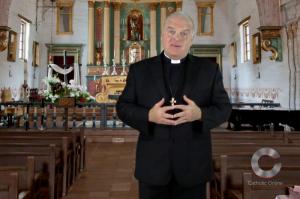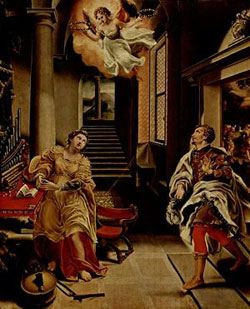 Dear readers, Catholic Online was de-platformed by Shopify for our pro-life beliefs. They shut down our Catholic Online, Catholic Online School, Prayer Candles, and Catholic Online Learning Resources essential faith tools serving over 1.4 million students and millions of families worldwide. Our founders, now in their 70's, just gave their entire life savings to protect this mission. But fewer than 2% of readers donate. If everyone gave just $5, the cost of a coffee, we could rebuild stronger and keep Catholic education free for all. Stand with us in faith. Thank you. Help Now >
Dear readers, Catholic Online was de-platformed by Shopify for our pro-life beliefs. They shut down our Catholic Online, Catholic Online School, Prayer Candles, and Catholic Online Learning Resources essential faith tools serving over 1.4 million students and millions of families worldwide. Our founders, now in their 70's, just gave their entire life savings to protect this mission. But fewer than 2% of readers donate. If everyone gave just $5, the cost of a coffee, we could rebuild stronger and keep Catholic education free for all. Stand with us in faith. Thank you. Help Now >
Sign of the Cross
The sign of the cross is a form of Catholic blessing whereby a person traces a symbolic cross on their body, or in the air in commemoration of the crucifixion of Christ. The sign of the cross is used in several Christian traditions, but it is most prominent in Catholic and Orthodox tradition.
The sign of the cross represents the victory of Jesus Christ over death. It is also used as an improvised prayer to ward off evil or to bless oneself in a time of prayer or need.
In its most common Roman Catholic form, the sign of the cross is made by touching one's forehead with a finger or a few, then the chest, then the front of the left shoulder, and finally the front of the right shoulder.
The formal and proper form of the sign of the cross includes the use of three fingers, especially when entering the church. The sign is a reminder of one's baptism. Using Holy Water, found in fonts at the entrance, further connects the sign to Baptism. In contemporary Church design, the Baptismal font is in the front to further signify the connection.
There are more elaborate forms, but people are generally free to perform the sign as they please so long as the gesture is respectful and offered in the full sincerity of the faith. It is inappropriate to offer the sign of the cross in irreverent or insincere fashion. Also, the sign of the cross made in the air with the hand, as a blessing for the faithful, is reserved for the use of ordained clergy, Bishops, Priests and Deacons.
More elaborate forms involve the use of three fingers, or making a small cross with the thumb and forefinger. When a cross is made with the thumb and forefinger, the person sometimes ends the sign by kissing their improvised cross. Some people prefer to touch the chest a second time, after their front right shoulder. This second touch represents the fifth wound of Christ.
In the Roman Catholic Liturgy, also called the Holy Mass, when the gospel reading is announced by the Priest or Deacon, Catholics use their thumb and forefinger to make a cross, then trace a tiny cross - first on their forehead, then their lips, and finally over their heart. This is a prayer, asking God to indelibly imprint the message of the Gospel in the mind, on the lips, and in the heart. In other words, inviting the Lord to sanctify their thoughts, their speech and their way of life through His Holy Word.
The sign of the cross can be made in any position, but is commonly paired with the act of genuflection (kneeling on one knee as a sign of respect). The sign of the cross is also made during prayer, often on two knees, but it can also be performed standing up, or even lying down, as in the case of a person who is ill.
Prayers are usually started and finished with the sign of the cross as well as the Catholic Mass and other Liturgical services such as the Liturgy of the Hours, Exposition and Benediction of the Blessed Sacrament or Litanies. The sign of the cross often the first thing a Catholic Christian does upon waking, and the last thing done before bed.
On Ash Wednesday, the ashes are applied to the forehead by a priest, deacon or extraordinary minister in the shape of a cross, to mark the penitents expressed choice to spend the forty days of Lent in prayer, repentance and fasting.
The sign of the cross can also be done with holy water. As mentioned above, it is often made by Catholics whenever they enter a church building and again upon exiting. Fonts of holy water are placed next to entrances for this purpose. Some people place small fonts at the doorway of their home for the same purpose.
Since Catholics use the sign of the cross so commonly, the gesture itself is considered synonymous with the Catholic Christian faith. It is frequently used in movies to show that a character is a devout Catholic. However, the sign of the cross can be made by any Christian and other Christian communities also use the sign, including Anglicans, Lutherans, Methodists, and Presbyterians.
Eastern Christians, both those who are members of the Orthodox Churches and Byzantine or Eastern Catholics in union with Rome, all make the sign of the Cross. However, they begin with the right shoulder rather than the left, as is the practice of Latin Rite or Western Catholics.
Catholic writer Bert Ghezzi says the sign of the cross has six meanings. "The sign of the cross is: a confession of faith; a renewal of baptism; a mark of discipleship; an acceptance of suffering; a defense against the devil; and a victory over self-indulgence."
The sign of the cross is a serious and powerful prayer ? and a holy symbol. It is a shield and a sword. It dedicates what you do in the name of Jesus Christ. It brings God's blessing. It's not a good luck charm, but it is a sign that says you are willing to accept the suffering of the Cross. So, when you make it, you are affirming your faith in Jesus Christ and your willingness to suffer for Him. It is a prayer in and of itself. Many of the Christian faithful begin every morning, the moment they awaken, by making that sign which says it all, even without the need for words.
More Prayers
Advent Prayers
Angel Prayers
Ash Wednesday Prayers
Babies Prayers
Baptism Prayers
Basic Prayers
Biblical Prayers
Birthday Prayers
Career Prayers
Children Prayers
Christ Prayers
Christmas Prayers
Communion Prayers
Confession Prayers
Congregation of the Blessed Sacrament Prayers
Consolation Prayers
Crucifix Prayers
Danger Prayers
Devotion Prayers
Disasters Prayers
Divinity Prayers
Dying Prayers
Easter Prayers
en Español Prayers
Evening Prayers
Faith Prayers
Family Prayers
Forgiveness Prayers
God Prayers
Grace Prayers
Guardian Angel Prayers
Guidance Prayers
Haiku Prayers
Healing Prayers
Holiday Prayers
Holiness Prayers
Holy Spirit Prayers
Home Prayers
Hope Prayers
Inspiration Prayers
Intercession Prayers
Invocation Prayers
Jesus Christ Prayers
Lent Prayers
Life Prayers
Litanies Prayers
Love Prayers
Marian (Mary) Prayers
Marriage Prayers
Martyrs Prayers
Mass Prayers
Meals Prayers
Morning Prayers
Motherhood Prayers
Other Prayers
Peace Prayers
Perseverance Prayers
Pope Prayers
Pope Francis I Prayers
Pope Leo XIII Prayers
Pope Pius XII Prayers
Praise Prayers
Prayers as Blessings
Prayers by Pope John Paul II
Prayers by St. Francis de Sales
Prayers for the Pope
Prayers in French
Prayers in German
Prayers in Latin
Prayers in Spanish
Prayers of the Church
Prayers of the Cross
Priests Prayers
Pro Life Prayers
Prosperity Prayers
Protection Prayers
Purgatory Prayers
Repentance Prayers
Requests Prayers
Saint Prayers
Salvation Prayers
Sick Prayers
Special Intentions Prayers
St. Anthony of Padua Prayers
St. Gregory the Great Prayers
St. Joseph Prayers
St. Patrick Prayers
St. Valentine Prayers
Stewardship Prayers
Strength Prayers
Study Prayers
Thanks Prayers
The Rosary in Croation
The Rosary in Dutch
The Rosary in English
The Rosary in French
The Rosary in German
The Rosary in Irish-Gaelic
The Rosary in Italian
The Rosary in Latin
The Rosary in Polish
Travel Prayers
Trust Prayers
Virtue Prayers
Vocation Prayers
Wedding Prayers
Wisdom Prayers
Join the Movement
When you sign up below, you don't just join an email list - you're joining an entire movement for Free world class Catholic education.
-

- Easter / Lent
- Ascension Day
- 7 Morning Prayers
- Mysteries of the Rosary
- Litany of the Bl. Virgin Mary
- Popular Saints
- Popular Prayers
- Female Saints
- Saint Feast Days by Month
- Stations of the Cross
- St. Francis of Assisi
- St. Michael the Archangel
- The Apostles' Creed
- Unfailing Prayer to St. Anthony
- Pray the Rosary
Kyrie: The Ancient Prayer that Echoes ‘Lord’
Love Stronger Than Death – Pope Leo Calls Christians to Remember the Martyrs
Top 10 Countries for Catholic Retirement in 2025
Daily Catholic
 Daily Readings for Tuesday, September 16, 2025
Daily Readings for Tuesday, September 16, 2025 St. Cornelius: Saint of the Day for Tuesday, September 16, 2025
St. Cornelius: Saint of the Day for Tuesday, September 16, 2025 Ave Maria - Hail Mary: Prayer of the Day for Tuesday, September 16, 2025
Ave Maria - Hail Mary: Prayer of the Day for Tuesday, September 16, 2025 Daily Readings for Monday, September 15, 2025
Daily Readings for Monday, September 15, 2025 St. Valerian: Saint of the Day for Monday, September 15, 2025
St. Valerian: Saint of the Day for Monday, September 15, 2025- Prayer to Our Lady of Perpetual Help: Prayer of the Day for Monday, September 15, 2025
![]()
Copyright 2025 Catholic Online. All materials contained on this site, whether written, audible or visual are the exclusive property of Catholic Online and are protected under U.S. and International copyright laws, © Copyright 2025 Catholic Online. Any unauthorized use, without prior written consent of Catholic Online is strictly forbidden and prohibited.
Catholic Online is a Project of Your Catholic Voice Foundation, a Not-for-Profit Corporation. Your Catholic Voice Foundation has been granted a recognition of tax exemption under Section 501(c)(3) of the Internal Revenue Code. Federal Tax Identification Number: 81-0596847. Your gift is tax-deductible as allowed by law.






 Daily Readings for Tuesday, September 16, 2025
Daily Readings for Tuesday, September 16, 2025 St. Cornelius: Saint of the Day for Tuesday, September 16, 2025
St. Cornelius: Saint of the Day for Tuesday, September 16, 2025 Ave Maria - Hail Mary: Prayer of the Day for Tuesday, September 16, 2025
Ave Maria - Hail Mary: Prayer of the Day for Tuesday, September 16, 2025 St. Valerian: Saint of the Day for Monday, September 15, 2025
St. Valerian: Saint of the Day for Monday, September 15, 2025

